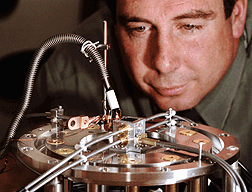Caught in the grip of a crushing magnetic force:
New technique tests, may create, materials
|

MY BABY — With tender care, Sandia researcher Clint Hall examines one of his group's ICE experiments that created a material response curve for lithium fluoride.
(Photo by Randy Montoya)
Download 300dpi JPEG image, ‘ICE.jpg’, 1.5MB (Media are welcome to download/publish this image with related news stories.)
|
ALBUQUERQUE, N.M. — The physical pressures of rapidly accelerating a jet plane or fast car, or diving several atmospheres beneath the sea’s surface, test human toughness.
But the limited range of conditions in which even the fittest can flourish is brought into sharp relief by pressures increasing from zero to a million atmospheres in a few billionths of a second at a machine called Z at the Department of Energy’s Sandia National Laboratories.
No human could survive this force, which is used to generate temperatures rivaling the sun and explosions resembling the X-ray outbursts of neutron stars.
But fuller understanding by researchers of such pressures has given birth to a “cool” new technique, without explosions and at merely the temperature of boiling water.
The technique — so relatively cold that tongue-in-cheek researchers have dubbed it ICE (for Isentropic Compression Experiments) — is a far faster and less expensive way than any available to test materials over a wide range of stress.
Compared with current techniques for characterizing materials, “ICE will cut costs by an order of magnitude,” says Sandia project head Clint Hall.
The huge force may help to:
- Create ultrahard matter (in the same way that extreme pressures in Earth’s interior make diamonds from coal);
- Form better computer models to predict the effects of the impacts of hypervelocity micrometeorites on space stations;
- Answer basic physics questions such as whether a liquid, rapidly compressed, will become a solid.
The immediate goal of the technique is to aid DOE’s stockpile stewardship program by providing data describing how materials react as pressures on them increase in this way, says Hall.
Stockpile stewardship is a term used to describe the U.S. program to maintain nuclear weapons by simulating their maintenance, explosion, and effects without physically testing them.
“We try to develop models that describe how a material will change in volume at a given temperature and pressure — its equation of state. Without knowing that relationship, one can’t have confidence in how a structure is going to react to applied forces,” says Hall.
Also, says Jim Asay, deputy director of Sandia’s Weapon Science Applications group, “Facilities throughout the world interested in developing inertial fusion capabilities [a method of banging atoms together to make their nuclei join, releasing large amounts of energy] should benefit from this technique because it can characterize the equations of state of materials used in target capsules and other portions of such procedures.”
Heresy produces progress
The experiments require a transformation of Z’s target that might seem heretical to those who have followed the remarkable successes in power output and temperature of the machine’s recent past. That output enabled Z to provide data to help interpret neutron star and black hole observations by astronomers.
For ICE, scientists remove the cylindrical target array of fine wires that created an explosion when ionized.
In their place, researchers have inserted a target of four plates, each a bit bigger than a postage stamp, several millimeters thick, and arranged at right angles to each other like a tiny fort.
The massive incoming current creates a rapidly increasing magnetic compression through each plate that acts as a kind of ram against materials secured there.
“The pressure wave generated from Z travels through the material at 15,000 to 30,000 feet per second, which is five to 10 times faster than a bullet from a conventional firearm,” says Hall. “Shock physics hasn’t had access to a machine that can create pressure pulses like this. With electromagnetics, we can help understand how materials react to pressure profiles useful for fusion, aiding the DOE’s inertial confinement program to achieve the most effective target configuration.”
ICE has contracted for 18 shots at Z through the current fiscal year. So far, five have been scheduled by researchers from Lawrence Livermore National Laboratory (LLNL), and five from Sandia. LLNL scientists were quick to recognize the implications for ICE on Z and have partnered with Sandia in ICE’s development and application to stockpile stewardship programs. “These extensive computer simulations, performed by David Reisman, of LLNL, were instrumental in defining experimental configurations and data analysis methods for accurate ICE measurements on Z,” says Asay.
Two papers on the research have been accepted for publication in the Proceedings of the American Institute of Physics; another has been accepted by the Physics of Plasma.
The new technique is born
ICE began when it proved impossible to measure electrical current by conventional means at the target of Z. When fired in its usual configuration, Z releases in X-rays, for a fraction of a second, about 80 times the entire Earth’s electrical generating capacity. This makes it difficult for instruments to collect accurate measurements of internal forces. Pressure was the most easily measured and sure indicator of the huge current passing through Z’s focal point, or target.
Then, in an innovative leap, investigators realized that pressure, besides being an indicator, also could be a powerful actor, functioning as a new, better way to rapidly test materials than gas gun firings, the usual method for testing materials at high pressures.
A short disquisition on gas guns
Gas guns fire a succession of projectiles with greater and greater force at the material to be tested.
While a single firing of Z costs about six times a typical high-pressure shot from a gas-powered gun, Z produces complete equation-of-state curves for as many as four materials at once. Gas-powered gun shots yield only individual data points that must be interpolated to form a graph, these only a single material at a time, with an average of ten shots per material. The savings add up.
The impact from a gas gun shot also produces tremendous heat. “If you shock a material, it tries to go to a high temperature, making it difficult to further compress it,” says Bob Cauble, an LLNL researcher working with ICE. “When it is hot, the material presses back against a compressive force. But if you gently squeeze it in an isentropric manner, you can squeeze further.”
The Sandia research project is called ICE because rather than taking place at more than a million degrees Celsius, ICE experiments are conducted at only 100 degrees. (Temperatures reached after conclusions of the experiments do approach 10,000 degrees.)
Current testing
Sandia has now tested aluminum and copper in order to compare ICE results to benchmarks obtained by already accepted methods. Now being tested by Reisman, the LLNL principal investigator for ICE studies, are tantalum, beryllium, molybdenum, and iron. Cauble and Reisman use the ICE technique at Sandia’s Z machine to provide high pressure, equation-of-state data for Livermore physics researchers to benchmark models and guide condensed matter theories.
The tremendous magnetic field generated by Z’s 20 million incoming amperes grows from 0 to 14.7 million pounds per square inch of pressure. This occurs on a target of a few hundred milligrams in less than 160 nanoseconds.
Other Z stories
Sandia is a multiprogram laboratory operated by Sandia Corporation, a Lockheed Martin Company, for the United States Department of Energy under contract DE-AC04-94AL85000. With main facilities in Albuquerque, N.M., and Livermore, Calif., Sandia has major research and development responsibilities in national security, energy and environmental technologies, and economic competitiveness.
Media contact:
Neal Singer, nsinger@sandia.gov, (505) 845-7078
Technical contacts:
Clint Hall, chall@sandia.gov, (505) 845-3300
Jim Asay, jrasay@sandia.gov, (505) 844-1506
|
